Learn How to make Vegetable Broth at home. It’s easy, flavorful and perfect for making soups, stews, sauces and more!
It makes the perfect base for this vegetable soup recipe, Instant Pot vegetable soup and Mexican vegetable soup.
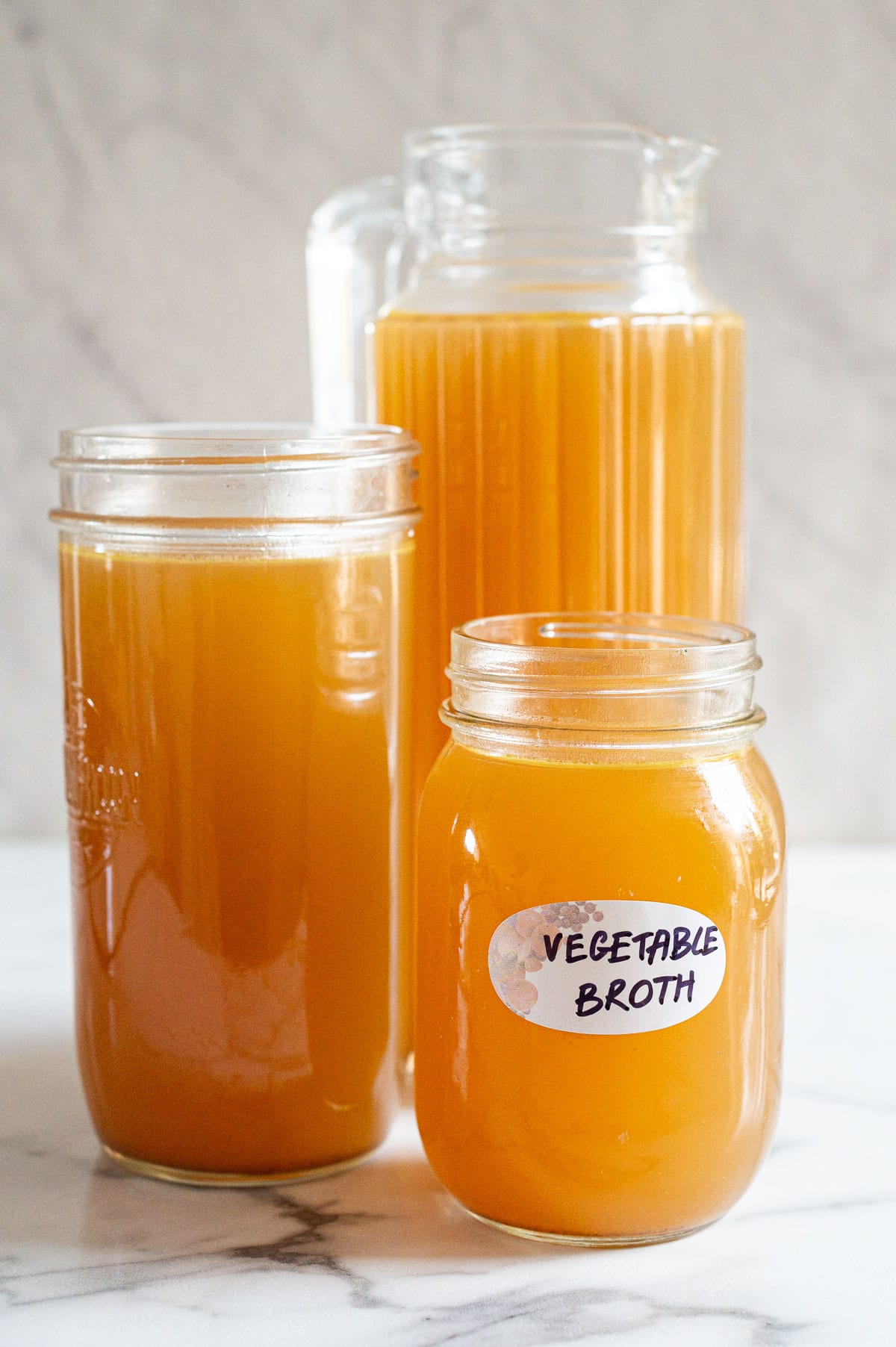
Table of Contents
- Why You’ll Love This Recipe
- Ingredients for Homemade Vegetable Broth
- What Vegetable Scraps to Save for Vegetable Broth?
- What Vegetables Not to Use in Vegetable Broth?
- How to Make Vegetable Broth
- Tips for Best Results
- Variations
- How to Store
- FAQs
- Use Vegetable Broth in These Recipes
- How to Make Vegetable Broth Recipe
I often buy store-bought vegetable base and I shouldn’t. Homemade vegetable broth is so easy to make and so much more tasty, it just requires some planning.
I am going to try to do it more often by saving veggie scraps in the freezer! Then you can use it in soup recipes, in place of water to make rice and quinoa, or just casually sip on a cup of delicious fresh veggie broth!
Why You’ll Love This Recipe
- It’s fast: Unlike chicken broth recipe, it’s ready in 45 minutes.
- No skimming: Again, unlike any meat broth like Instant Pot beef bone broth, no skimming of foam or fat is necessary.
- More flavor than store-bought: Your vegetable broth will be rich with a depth of flavor that doesn’t compare to store-bought.
- Saves money: This vegetable broth recipe makes 12 cups and will last weeks in the fridge or freezer.
Ingredients for Homemade Vegetable Broth
Here are the basic ingredients you need to make your own flavorful vegetable broth.
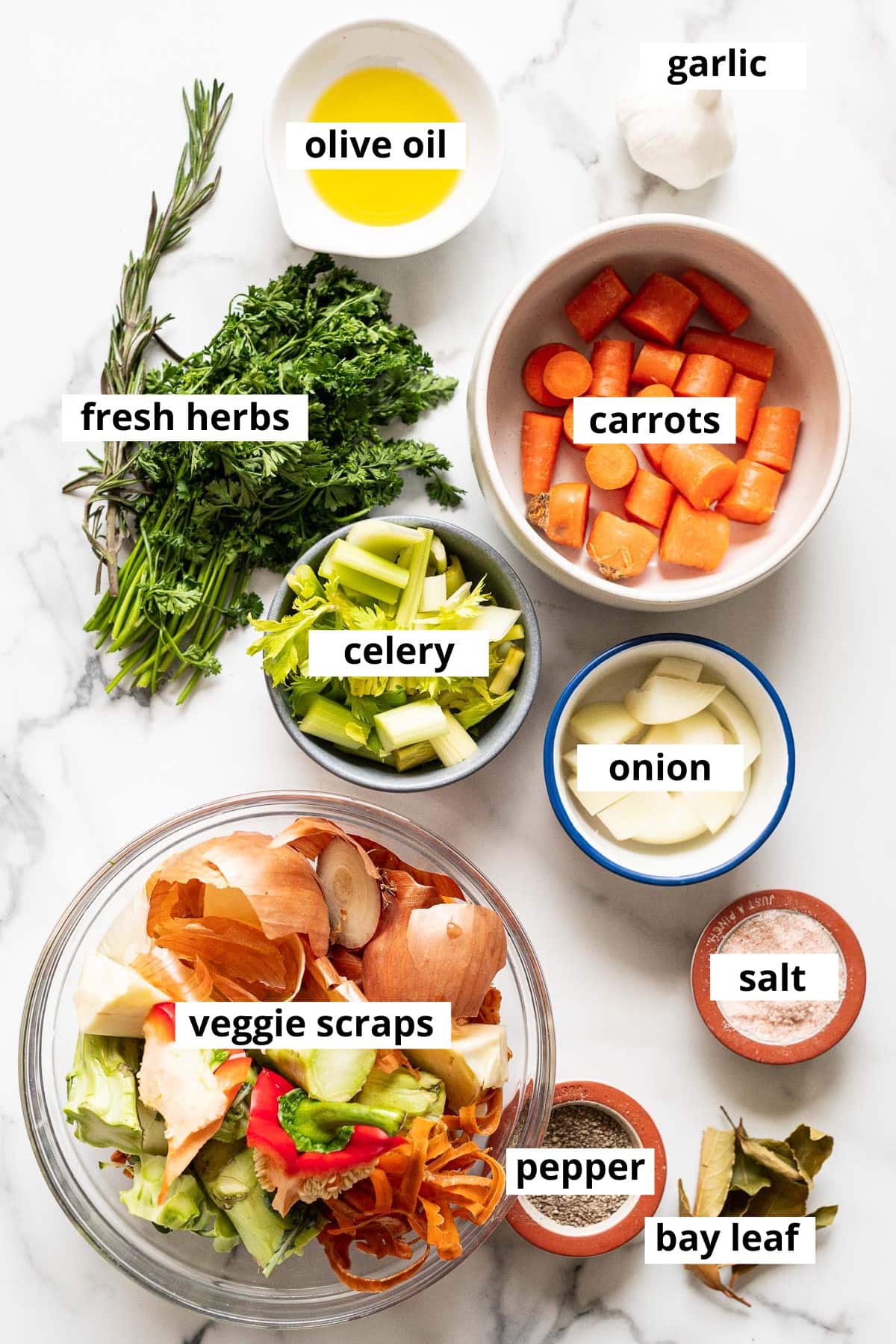
- Must-add vegetables: Onion, shallots or leeks; carrot, and celery. These vegetables enhance depth, flavor, and body.
- Veggie scraps: This time I added carrot peels, celery ends, broccoli stems, pepper cores, and onion peels. See more below for a full list.
- Garlic is nice: Not necessary but it adds good flavor. I like to cut it in half and sauté first.
- Optional: Fresh herbs would also add nice flavor. I had a wilting bunch of fresh parsley, so I tossed that in.
- Quality olive oil: Choose a flavorful oil like extra-virgin olive oil. I prefer it to mild oil like avocado oil because it makes part of the vegetable broth.
- Seasonings: Bay leaves, salt and pepper.
What Vegetable Scraps to Save for Vegetable Broth?
Keep it simple and don’t make any extra trips to the store to grab ingredients you wouldn’t already have on hand. Use any vegetable scraps, peels, ends, cores, or limp veggies you normally buy and freeze them!
Here’s a few that would add sweetness and depth of flavor.
- Bell pepper cores.
- Mushroom stems.
- Tops or ends of tomatoes, sweet potatoes or butternut squash.
- Stems from fresh herbs such as fresh thyme, parsley, cilantro, or rosemary.
- Leafy green stems.
Recipe Tip
You broth will be a little different every time. There’s no set recipe but as long as you don’t go overboard with one ingredient or other, it will be delicious every time!
What Vegetables Not to Use in Vegetable Broth?
In general, most vegetable scraps can be added to your homemade broth but there are a few I avoid because they could add a bitter taste.
- Cruciferous vegetables: Like broccoli, cauliflower, cabbage, kale, bok choy, mustard greens, and brussels sprouts.
- Bland vegetables: Like zucchini, green beans and potatoes.
- Citrus: Peels from lemon, lime, oranges etc.
- Certain herbs: A bit is OK, as you can see I added 1 rosemary sprig.
Recipe Tip
Other things that can make broth bitter are too many of certain carrot greens and tops, onion peels and ends, and outer celery leaves. Also some dried herbs, too many tomato seeds, and simply cooking broth for too long.
How to Make Vegetable Broth
Here’s a quick and easy overview of how to make vegetable broth. You’ll need a large pot or Dutch oven, and a fine mesh strainer.
There is a full recipe card below.
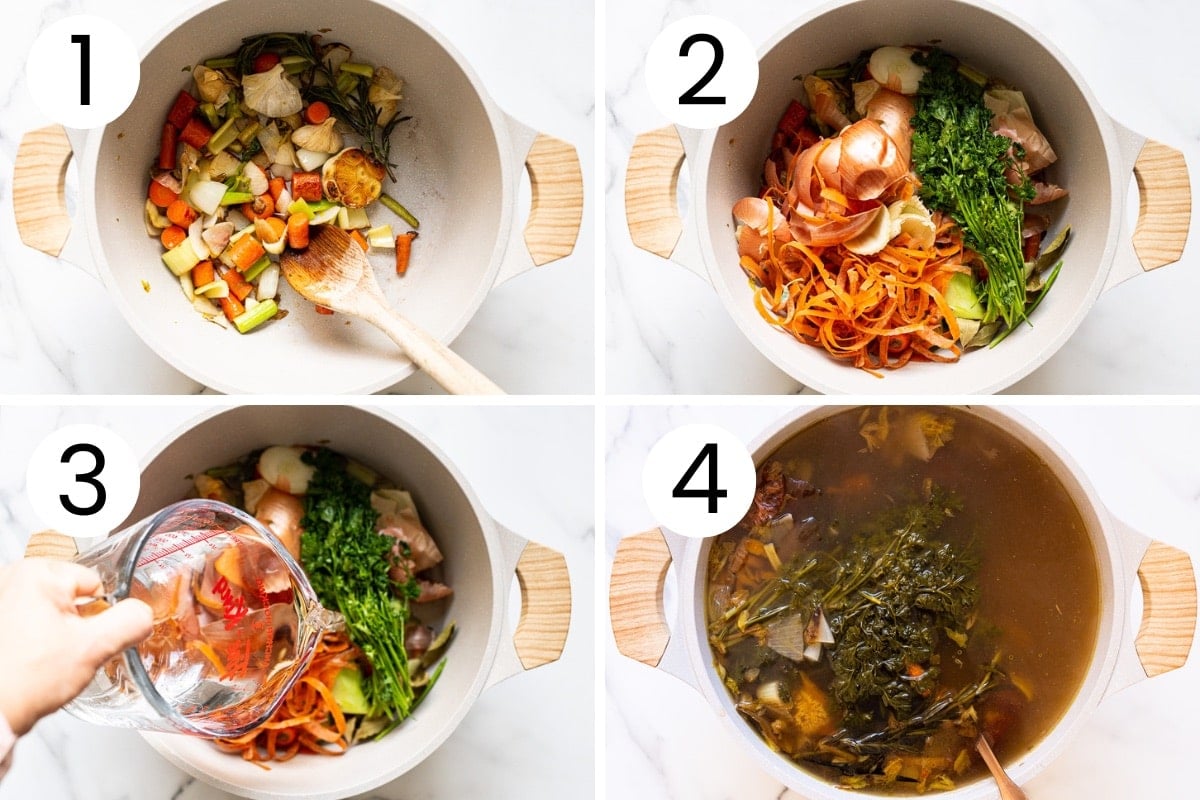
- Sauté must-add vegetables: Heat a large pot on medium heat and add olive oil. Add onion, carrots, celery and garlic and sauté for 5 minutes.
- Add scraps and herbs: To the same pot, add veggie scraps, fresh herbs, and bay leaves.
- Cover with water: Fill the pot almost to the top with cold water, cover with lid.
- Simmer: Bring to a boil then reduce heat to low and gently simmer for at least 45 minutes. Feel free to simmer for up to 2 hours for a more flavorful veggie broth.
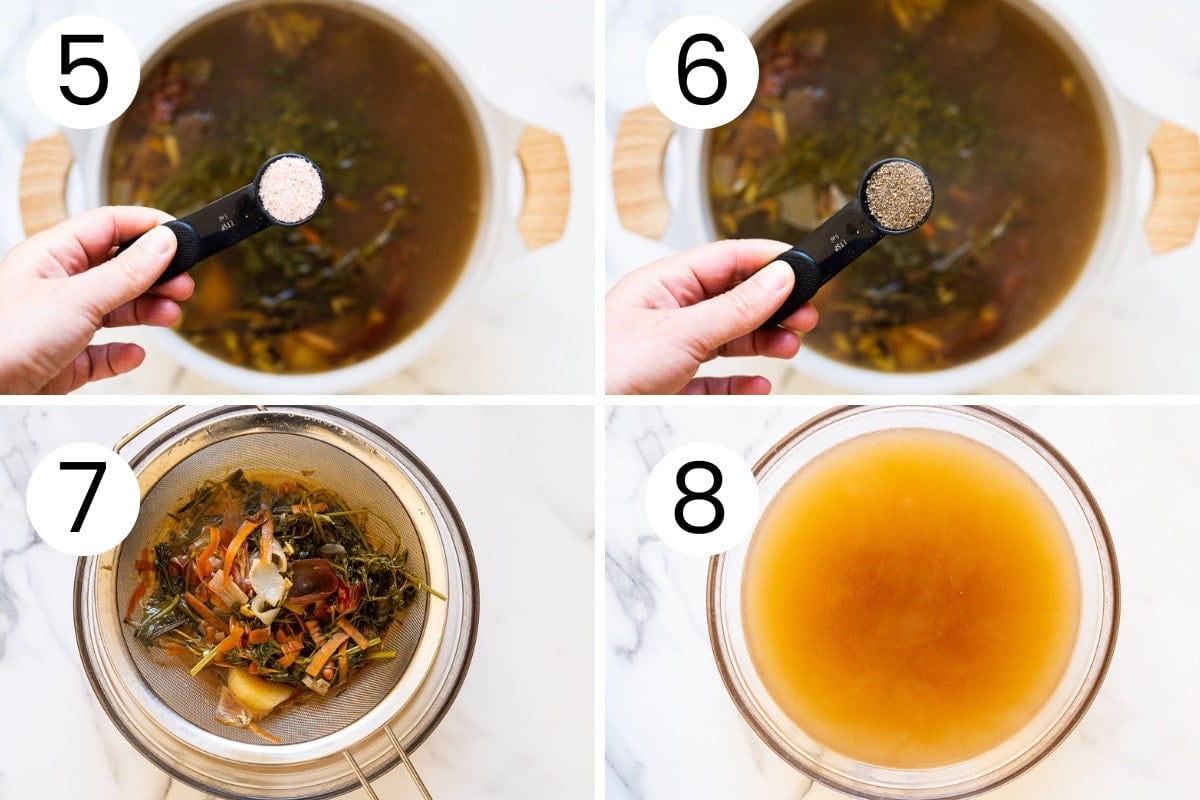
- Season the broth: Remove lid and sprinkle with salt and pepper to taste, I like to start with 1 teaspoon salt and 1/2 teaspoon pepper.
- Strain: Pour broth through a large fine mesh strainer over a large bowl.
- Let it cool: Use a funnel to divide vegetable broth between large Mason jars or airtight containers. Let cool to room temperature and store in fridge or freezer.
Tips for Best Results
Here are my expert tips that will boost the flavor and quality of your vegetable broth.
- Be sure veggie scraps are clean: Before freezing, be sure to wash the scraps. No one wants dirt soup.
- Save “fresh scraps”: Washed and unpeeled carrot is fine where as washed moldy carrot is not.
- Use cold water: This allows the veggies to release flavor slowly without breaking down.
- Don’t add too much salt but also don’t skip it: Salt helps enhance the taste but because you’ll probably be using it in other recipes that call for salt, you don’t want to add too much.
- Make it more concentrated: Use less water, 3/4 pot full of water.

Variations
As I mentioned above, this basic recipe will taste different every time but it’s also adaptable. Here’s a few ways you can customize it even more.
- Asian inspired: Add fresh ginger, shiitake stems and lemongrass.
- Add color: A bit of turmeric will give the broth a golden color and add a hint of peppery spice.
- Mushroom broth: Omit veggie scraps and add 3 cups of mushroom stems or use fresh mushrooms.
- Corn broth: Save corn cobs and add them to the broth to simmer.
- Make it sweet: Add apple or pear pieces, cores, or peels.
- Add tang: One tomato will give it a touch of tang.
How to Store
Store: If you’ll be using your broth right away you can store it in the fridge for up to 4 days.
Freeze: Store in jars or freezer-safe containers with leak proof lids, leaving a few inches from the top for expansion.
Or pour into individual ice cubes for using in recipes that call for a small amount, like gravy.
Reheat and reuse: Bring cold broth to a boil on stove top and then proceed with soup or chili recipe. Or add cold to slow cooker recipes.
FAQs
If you have made your broth properly, the vegetables should be flavorless, nutrition-less mush and they’re only good for the compost. Or carrots are good for dog food.
Yes, vegetable broth and vegetable stock are the same. You can’t technically make vegetarian stock because veggies don’t contain gelatin. Stock is generally sodium-free, so grocery stores may label theirs as broth if it contains salt.
After cooking add a splash of soy sauce or mix some miso paste with a bit of broth and add to the pot.
Before cooking add a splash of wine, a handful of dried mushrooms, roast, or grill some vegetables, or stir in tomato paste after sauteing the veggies.
Yes, sauté veggies in a skillet, then slow cook everything on Low for 8-10 hours or on High for 4-5 hours.
Yes, sauté veggies first then pressure cook for 30 minutes with Natural Release.
Use Vegetable Broth in These Recipes
- Ukrainian borscht
- Vegetarian borscht
- Beef vegetable soup
- Lentil spinach soup
- Instant Pot cabbage soup
- Vegetarian pasta fagioli
- Slow cooker lentil soup

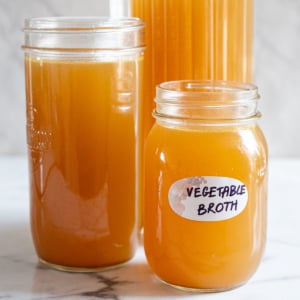
How to Make Vegetable Broth
Equipment
Ingredients
- 1 medium onion coarsely chopped
- 3 medium carrots coarsely chopped
- 3 large celery ribs coarsely chopped
- 1 head of garlic cut in half
- 3 cups veggie scraps or more veggies of choice
- Fresh herbs optional
- 4 bay leaves
- 16 cups cold water
- 2 tablespoons olive oil extra virgin
- 2 teaspoons salt
- 1 teaspoon ground black pepper
Instructions
- Preheat large pot on medium heat and add olive oil. Then add onion, carrots, celery and garlic. Saute for 5 minutes, stirring occasionally.
- Then add veggie scraps, fresh herbs, bay leaves and cold water to almost the top of the pot. Cover with a lid and bring to a boil, then reduce heat to low and simmer gently for 45 minutes. The longer broth simmers, the more flavorful it is.
- Season broth with salt and pepper to taste, I like to start with 1 teaspoon salt and 1/2 teaspoon pepper. It depends what you will use it for. Then strain broth through a large fine mesh strainer over a large bowl.
- Using a funnel, divide vegetable broth between large Mason jars or airtight containers and let cool to room temperature.
Notes
- Store: Refrigerate chicken broth for up to 4 days or freeze for up to 3 months.
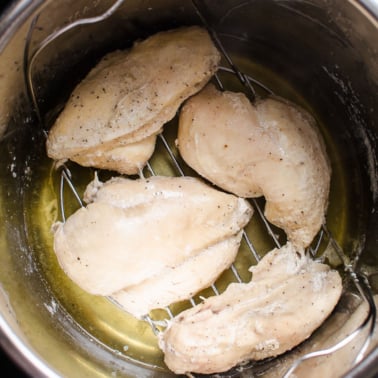
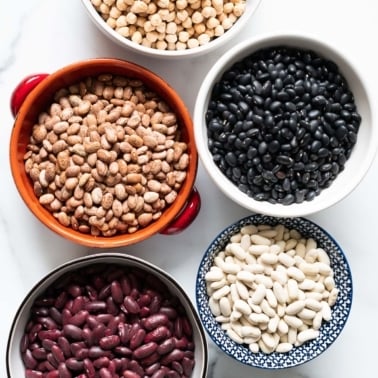
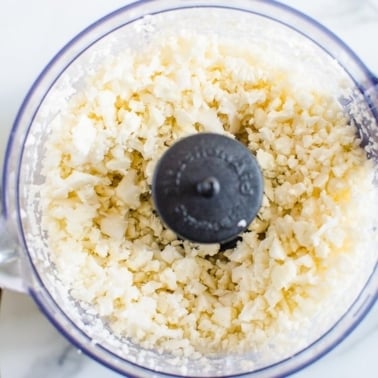









What’s the best way to freeze bones and vegetable scraps for broth? Just wash, dry and place in freezer bag until ready to use?
Thank you!
Correct. Wash veggies before peeling.